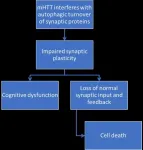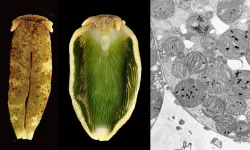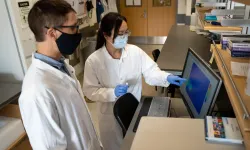(Press-News.org) Patients with advanced chronic kidney disease (CKD) typically suffer from impaired bone quality and quantity, with a non-vertebral fracture risk which is 4-to 6-fold higher than the fracture risk of matched controls. However, despite their high risk of fragility fractures, the vast majority of patients with chronic CKD stages 4 to 5D, are not receiving osteoporosis therapy.
A newly published review by the International Osteoporosis Foundation (IOF) and European Renal Association-European Dialysis and Transplant Association (ERA-EDTA) CKD-MBD working group now provides concise recommendations, with a clear management algorithm, to support clinicians' knowledge and confidence in managing osteoporosis in their patients1. The review summarises the recent 'European Consensus Statement on the Diagnosis and Management of Osteoporosis in Chronic CKD Stages G4-G5D'2. It outlines essential information on the diagnosis of osteoporosis; risk factors for fragility fractures; assessment of fracture risk; intervention thresholds for pharmacological intervention; non-pharmacological and pharmacological intervention; monitoring; and systems of care. The review also points to key research questions and future perspectives, and recommends that fracture liaison services integrate systematic identification and management of CKD patients with fragility fractures, in close collaboration with nephrologists as part of the multidisciplinary team.
Lead author, Dr Pieter Evenepoel, Department of Nephrology of the University Hospitals Leuven, Leuven, Belgium stated:
"Clinicians treating chronic kidney disease patients are often unsure about how to optimally manage bone health, resulting in inaction and a 'wait and see' approach in regard to preventative osteoporosis care. Now that recent studies suggest a similar efficacy of common osteoporosis drugs in patients with CKD stages G4-G5D as in the general patient population, it is time to foster a paradigm shift with regard to osteoporosis care in these patients. We hope that this succinct new review will serve to boost physicians' knowledge and confidence in managing osteoporosis in their patients."
Professor Serge Ferrari, co-author and Vice-Chair of the IOF Committee of Scientific Advisors, added:
"The number of people with advanced chronic kidney disease (CKD) and undergoing maintenance dialysis is rapidly increasing around the world. We expect that these pragmatic recommendations, which result from a successful collaboration between European societies, will help to stimulate a proactive and cohesive approach to the management of osteoporosis in this growing subset of patients at high risk of debilitating fragility fractures."
INFORMATION:
References
1. Evenepoel P, Cunningham J, Ferrari S, Haarhaus M, Javaid MK, Lafage-Proust MH, Prieto-Alhambra D, Torres PU, Cannata-Andia J, on behalf of the European Renal Osteodystrophy (EUROD) workgroup, an initiative of the CKD-MBD working group of the ERA-EDTA, and the Committee of Scientific Advisors and National Societies of the IOF, Diagnosis and management of osteoporosis in chronic kidney disease stages 4 to 5D: a call for a shift from nihilism to pragmatism. Osteoporos Int (2021). https://doi.org/10.1007/s00198-021-05975-7
https://rd.springer.com/article/10.1007/s00198-021-05975-7
2. Evenepoel P, Cunningham J, Ferrari S, Haarhaus M, Javaid MK, Lafage-Proust MH, Prieto-Alhambra D, Ureña Torres P, Cannata-Andia J, European Renal Osteodystrophy (EUROD) workgroup, an initiative of the CKD-MBD working group of the ERA-EDTA, and the Committee of Scientific Advisors and National Societies of the IOF, European consensus statement on the diagnosis and management of osteoporosis in chronic kidney disease stages G4-G5D, Nephrology Dialysis Transplantation, Vol. 36, Issue 1, 2021, Pages 42-59, https://doi.org/10.1093/ndt/gfaa192
About IOF
The International Osteoporosis Foundation (IOF) is the world's largest nongovernmental organization dedicated to the prevention, diagnosis and treatment of osteoporosis and related musculoskeletal diseases. IOF members, including committees of scientific researchers as well as 268 patient, medical and research societies, work together to make fracture prevention and healthy mobility a worldwide health care priority. https://www.osteoporosis.foundation @iofbonehealth
About ERA-EDTA
ERA-EDTA (The European Renal Association - European Dialysis and Transplant Association) is an organisation for clinicians and scientists in nephrology, dialysis, renal transplantation and related areas. The objectives of the Association are the advancement of medical science by promoting fundamental and clinical advances in the field of nephrology, dialysis, renal transplantation, hypertension, and related subjects. https://www.era-edta.org/en/
BOSTON - New research led by investigators at Massachusetts General Hospital (MGH) and Massachusetts Eye and Ear indicates that the blood pressure drug losartan may benefit patients with neurofibromatosis type 2 (NF2), a hereditary condition associated with vestibular schwannomas, or noncancerous tumors along the nerves in the brain that are involved with hearing and balance. The findings, which are published in Science Translational Medicine, are especially important because vestibular schwannomas are currently treated with surgery and radiation therapy (which carry risks of nerve damage), and no drug is approved by the U.S. Food and Drug Administration to treat these tumors or their associated hearing ...
Amsterdam, July 15, 2021 - Huntington's Disease (HD) is a progressive neurodegenerative condition characterized by motor, cognitive, and psychiatric symptoms, and motor symptoms are often preceded by cognitive changes. Recent evidence indicates that autophagy plays a central role in synaptic maintenance, and the disruption in autophagy may be at the root of these early cognitive changes. Understanding this mechanism better may help researchers develop treatments for patients with HD early in their disease progression, report scientists in a review article published in the Journal of Huntington's Disease.
In this review, experts describe how autophagy, the cellular process responsible ...
We sleep on average one third of our time. But what does the brain do during these long hours? Using an artificial intelligence approach capable of decoding brain activity during sleep, scientists at the University of Geneva (UNIGE), Switzerland, were able to glimpse what we think about when we are asleep. By combining functional magnetic resonance imaging (fMRI) and electroencephalography (EEG), the Geneva team provides unprecedented evidence that the work of sorting out the thousands of pieces of information processed during the day takes place during ...
The COVID-19 pandemic halted the in-person wintertime survey of wolves and moose on the island for the first time in 63 years. Consequently, there are no estimates of wolf or moose abundance for 2021, and the next estimates are scheduled in February 2022. But though the Isle Royale Winter Study didn't happen quite as planned, researchers were still able to visit the remote national park in the spring.
Now, fieldwork has resumed and Michigan Technological University researchers have already uncovered new information about these two iconic wildlife populations. In particular, wolves produced at least two litters of pups, and moose appear poised for decline.
In the Isle Royale Winter Study, Michigan ...
Plants, algae and some bacteria are able to perform photosynthesis, which is the process of transforming sunlight energy into sugar. Animals are generally unable to use this process to acquire energy, but there are a few known exceptions to this. Some sea slugs take up chloroplasts from the algae that they consume into their cells. These chloroplasts retain their ability to perform photosynthetic activity within the animal cells for several months, and thus provide them with photosynthesis-derived nutrition. This process is called "kleptoplasty", and it has attracted much attention due to its amazing uniqueness in making animals photosynthetic for over 50 years.
A pressing question is how these sequestered chloroplasts retains their photosynthetic capability without algal nuclei. ...
Since the Paris Climate Agreement that took effect in 2016, 121 countries have pledged to become carbon neutral by 2050 as the world tries to reduce its fuel consumption. The Korean government also unveiled its 2050 Carbon Neutral Strategy on December 7, 2020 and declared Carbon Zero, making transition to new and renewable energy a topic of conversation. Recently, a joint research team from POSTECH and Korea University has developed a radiative cooling material that can reduce energy consumption by selectively reflecting or transmitting sunlight.
A research team led by Professor Junsuk Rho, Ph.D. candidate Minkyung Kim, and Dr. Dasol Lee of POSTECH's departments of mechanical engineering and chemical engineering, and a team led by Professor Heon Lee and Soomin of the Department of Materials ...
Combined perceptions of the risk and availability of cannabis influence the risk of cannabis use more than perceived risk and perceived availability alone, according to a new study at Columbia University Mailman School of Public Health. Researchers observed that those who perceived cannabis as low-risk and available were more likely to report using the drug in the past year and almost daily compared to those individuals who perceived cannabis as high-risk and unavailable. This is the first study to consider the joint effects of perceived risk and perceived availability. The results are published in the journal Drug and Alcohol Dependence.
"Our study described the evolution of joint perceptions of cannabis risk and availability from 2002-2018 and estimated the relationship between combined ...
Adolescent girls and young women can and will use HIV prevention products with consistency, according to interim results of a study of two different methods: daily use of the antiretroviral (ARV) tablet Truvada® as oral pre-exposure prophylaxis (PrEP) and the monthly END ...
Shining a beam of light into potentially contaminated water samples may hold the key to real-time detection of hydrocarbons and pesticides in water.
UBC Okanagan researchers are testing the use of fluorescence to monitor water quality. The results, they say, show great promise.
When a beam of light is shone into the water, it excites the electrons in molecules of certain compounds and causes them to emit light. The characteristics of the emitted light are like a fingerprint and can be used to identify certain contaminants, explains Nicolas Peleato, an assistant professor at UBCO's School of Engineering.
"The challenge with using this fluorescence approach is that ...
Repairing complex electrical appliances is time consuming and rarely cost-effective. The working group led by Prof. Dr. Karl Mandel, Professorship of Inorganic Chemistry at Friedrich-Alexander-Universität Erlangen-Nürnberg (FAU), has now developed a smart microparticle that enables defective components in these appliances to be identified more quickly and easily by using light signals. In the long-term, this could make repairs easier and extend the operating life of devices. The results have been published in the journal Advanced Functional Materials.
To identify defective components in a device, particles known as supraparticles are applied to the individual parts. These particles measure between one and ten micrometres and under black light they provide information ...




